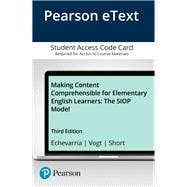Making Content Comprehensible for Elementary English Learners gives you a user-friendly approach for helping elementary English learners meet rigorous academic standards. You'll learn how to use the proven SIOP model to plan and implement lessons across content areas, grade levels and English proficiency levels.
Pearson eText is an easy-to-use digital textbook that you can purchase on your own or instructors can assign for their course. The mobile app lets you keep on learning, no matter where your day takes you -- even offline. You can also add highlights, bookmarks, and notes in your Pearson eText to study how you like.
NOTE: This ISBN is for the Pearson eText access card. Pearson eText is a fully digital delivery of Pearson content. Before purchasing, check that you have the correct ISBN. To register for and use Pearson eText, you may also need a course invite link, which your instructor will provide. Follow the instructions provided on the access card to learn more.










